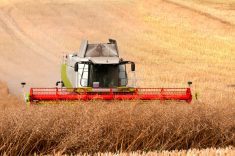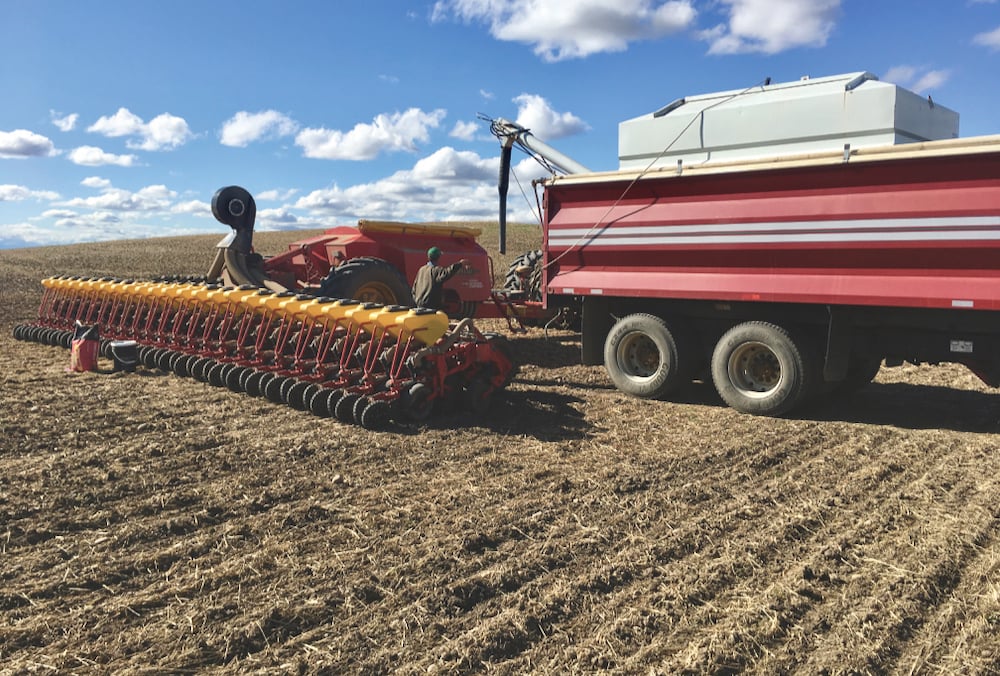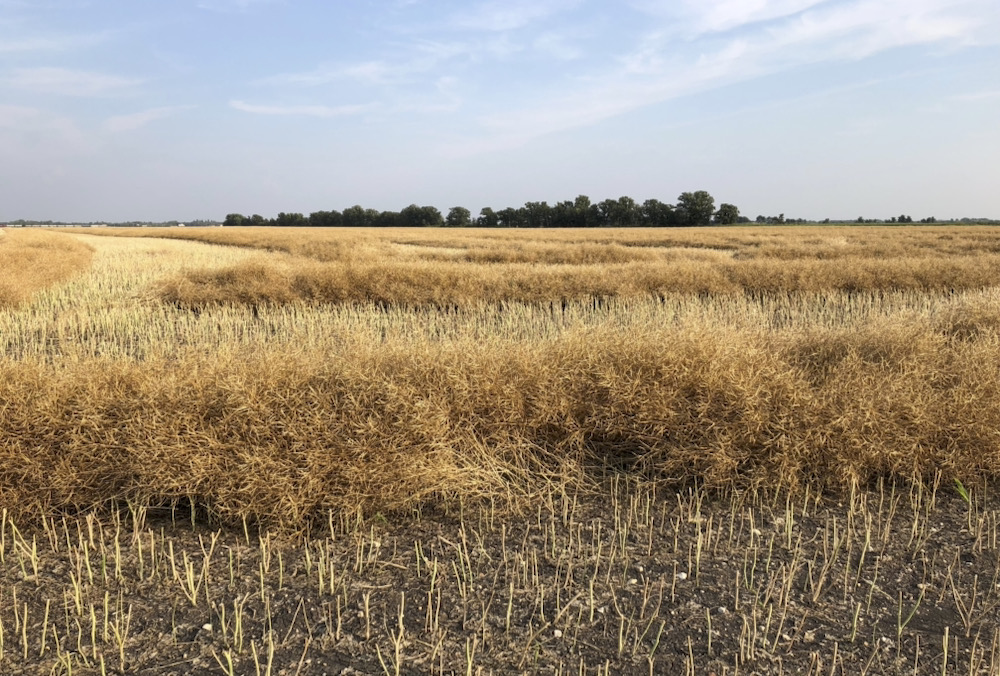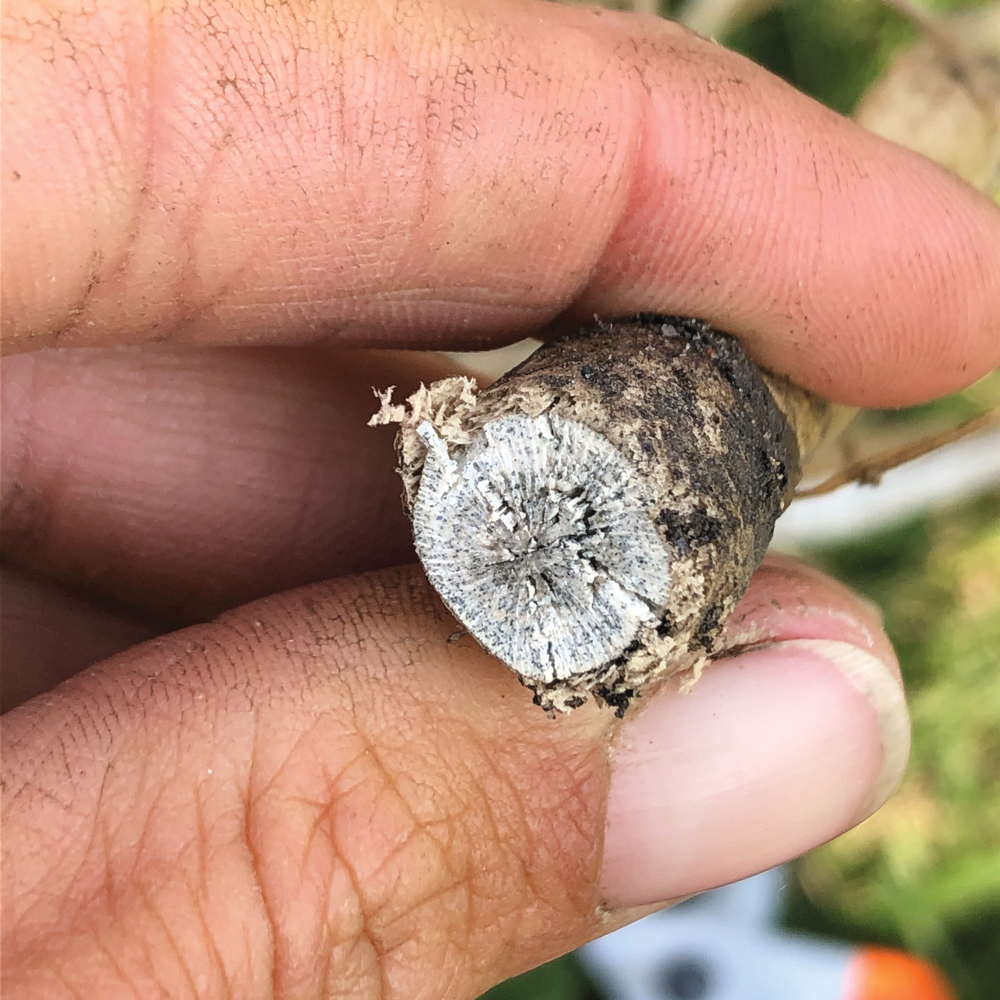Combines can easily throw more than a couple of bushels per acre of canola without drawing any notice from the operator. Yet that hidden loss can add up. Two bushels per acre tossed with the chaff amounts to $3,200 per 160 acres (based on the round number of $10 per bushel of canola) and it also contributes to the volunteer seed bank at a volume equal to 20 times the typical seeding rate.
“Losses will vary machine to machine, field to field, afternoon to evening, and there will be times when losses are much higher than two bushels per acre,” says Angela Brackenreed, agronomy specialist with the Canola Council of Canada. “Getting to know how these losses vary and being able to recognize high loss situations does require some work with a drop pan, but it can provide a pretty strong return on that time.”
Read Also

Producers aren’t panicking over tariffs and trade threats
The influence of tariff and trade uncertainity on farm business decisions.
Agronomy consultant Jim Bessel spoke about harvest loss management at the outdoor agronomy fest canolaPALOOZA in Alberta in June. He compares the time spent measuring combine losses to the time spent taking soil samples. “A soil test provides growers with a baseline to make soil fertility adjustments so they can get the most economic impact from the nutrients they’re applying,” Bessel says. “Harvest loss measurements provide that baseline for combine adjustments.”
The drop pan is like the soil test probe for combine loss evaluation. It’s an essential tool because electronic loss monitors are not accurate enough. They give you a vague idea whether losses are going up, but can’t say how many bushels per acre are thrown over.
“Time spent with the drop pan will give you a better idea what the loss monitors are telling you,” Brackenreed agrees.
Growers have three drop pan options. First is a deep-sided drop pan on a stick that the user holds under the back end of the combine. Deep sides will limit seed bounce out of the pan. Second is a wider pan the user tosses under the combine as it goes by. Third is a wide pan that attaches to the belly of the combine and releases with a switch.
How to sample for harvest loss
Step 1. Disengage the chaff spreader and straw chopper and move them out of the way so straw, chaff and thrown-over seeds drop straight down over the pan. This is important for accurate calculations.
Step 2. Position the pan. When using the pan on a stick, move the pan into position upside down so it doesn’t gather any losses ahead of time. Walk behind and to the side of the rear wheels and position the pan in front of the chaff and straw discharge area. Once the pan is in position, quickly flip it over and stop walking. Stand still until the combine has passed over the pan. This procedure provides the same result as throwing the pan, but the handle provides more precision when it comes to placement.
Step 3. Remove the straw and chaff and preserve only the seed. A screen works. Another method is to put the collected sample in the bottom of a five-gallon pail and use a blower or old hair dryer to blow out the lighter chaff and straw, leaving the seed behind.
How much loss is too much?
“Each farm will have a different concept of how much loss is too much,” Brackenreed says. “Loss of half a bushel to one bushel per acre is considered an ideal balance between putting more in the tank and getting harvest done in a timely and efficient manner.”
If losses are 2.0 bu./ac. or higher, slowing the combine ground speed may be the key to reducing those losses. See the sidebar next page for 10 ways to reduce combine losses, but growers may find that slowing the combine ground speed is an effective step.
Bessel says that growers may discover that slowing from four m.p.h. down to three m.p.h., for example, puts an extra 1.0 bu./ac. in the grain tank. While this would increase revenue from each quarter by $1,600, he says it also means two to three more hours to combine that quarter. There is a risk trade-off.
If growers can’t take that kind of time, Bessel encourages them to pencil out the cost of running a second combine so canola can be harvested at the slower ground speed and still get each quarter harvested in two to three fewer hours. If the combine is a rental and if it means an overall more timely harvest, this saved time creates economic value in addition to the saved bushel per acre, he says.
“The approach to combine loss management comes down to the grower’s perception of risk,” Brackenreed says. Is combining slower a higher risk than throwing over a bushel or two? Is buying another combine riskier financially than taking it slow with one unit? “Either way, the decision has to start with a true picture of combine losses and the cost they represent,” she says. “Measure how much the combine is throwing over.”
Bessel says measure first, then calculate, then adjust. “These need to be followed in sequence, otherwise you’re not accomplishing anything.”
Jay Whetter is communications manager for the Canola Council of Canada. For more on this topic, search for “harvest loss” at canolawatch.org. While at the site, why not sign up for the free weekly agronomy newsletter from the CCC? Growers may also be interested in the Harvest Loss Calculator available through Saskatchewan Soil Conservation Association at www.ssca.ca.
10 ways to reduce combine losses
- Check for leaks. Losses do not always come out the back end. Before making any adjustment to cylinder speed, concave spacing, fan speed or sieve spacing, check for holes and cracks on the pickup, feederhouse, elevator, shoe seals, separator covers and the grain tank.
- Start by setting the combine according to the operators’ manual recommendations for canola. Use a drop pan to check for losses. If losses are too high, adjust one variable at a time and check losses between each adjustment.
- Adjust fan speed to the point where seed is just beginning to blow over.
- Open chaffer and sieve settings as wide as you can tolerate.
- Avoid overthreshing. Straw pulverized into small pieces that drop down to the sieves will reduce airflow and separation — and increase losses. Cracked seed is another sign of overthreshing. Consider lowering the cylinder speed or widening the concave setting. This adjustment may also make it possible to drive faster and keep losses constant.
- Don’t assume canola separates easily. Unthreshed pods in the chaff mean the combine is underthreshing. Increase cylinder or rotor speed, narrow the concave setting, add concave blanks, or slow down.
- Know the combine. Rotaries work best with a narrow windrow, like a ribbon. Conventional walker combines work best with a wider swath that creates an even mat over the full width of the cylinder and walkers.
- Feed canola as uniformly as possible into the combine. Take time ahead of harvest to smooth out bunches left by the swather. Losses as these big bunches move through the combine can be huge.
- Travel at speeds that match a level of acceptable loss. It may take just a small decrease in speed — say 0.2 or 0.3 m.p.h. — to provide a significant reduction in losses. The loss curve tends to remain fairly flat until ground speed reaches a critical point when combine capacity is taxed, then the loss curve can rise steeply.
- Acknowledge that losses can vary from field to field and morning to afternoon to evening. With practice, growers will recognize conditions that increase or reduce losses and make adjustments throughout the day.
(Note: Jay compiled this list largely based on input from Les Hill with PAMI in Humboldt, Sask.)
How to calculate loss per acre
Step 1. Measure the seed in the pan by weight. Find a small scale that can measure in increments of 0.1 of a gram.
Step 2. Calculate based on one square foot. If the pan is two square feet, for example, divide the weight or volume by two to get the total for one square foot.
Step 3. Determine the concentration factor (CF) for the combine. This is a ratio of header cut width (swather or combine) and combine discharge width — a factor necessary to calculate losses per acre. For example, if the header is 30 feet and the discharge width is five feet, then the CF is “6.” (see Table 1 below).

Step 4. Plug these numbers into Table 2 (see below) to get losses in pounds per acre. If the cleaned sample weighs 6.2 grams per square foot and the combine CF is 6, the loss works out to 100 pounds per acre — or two bushels per acre.

















